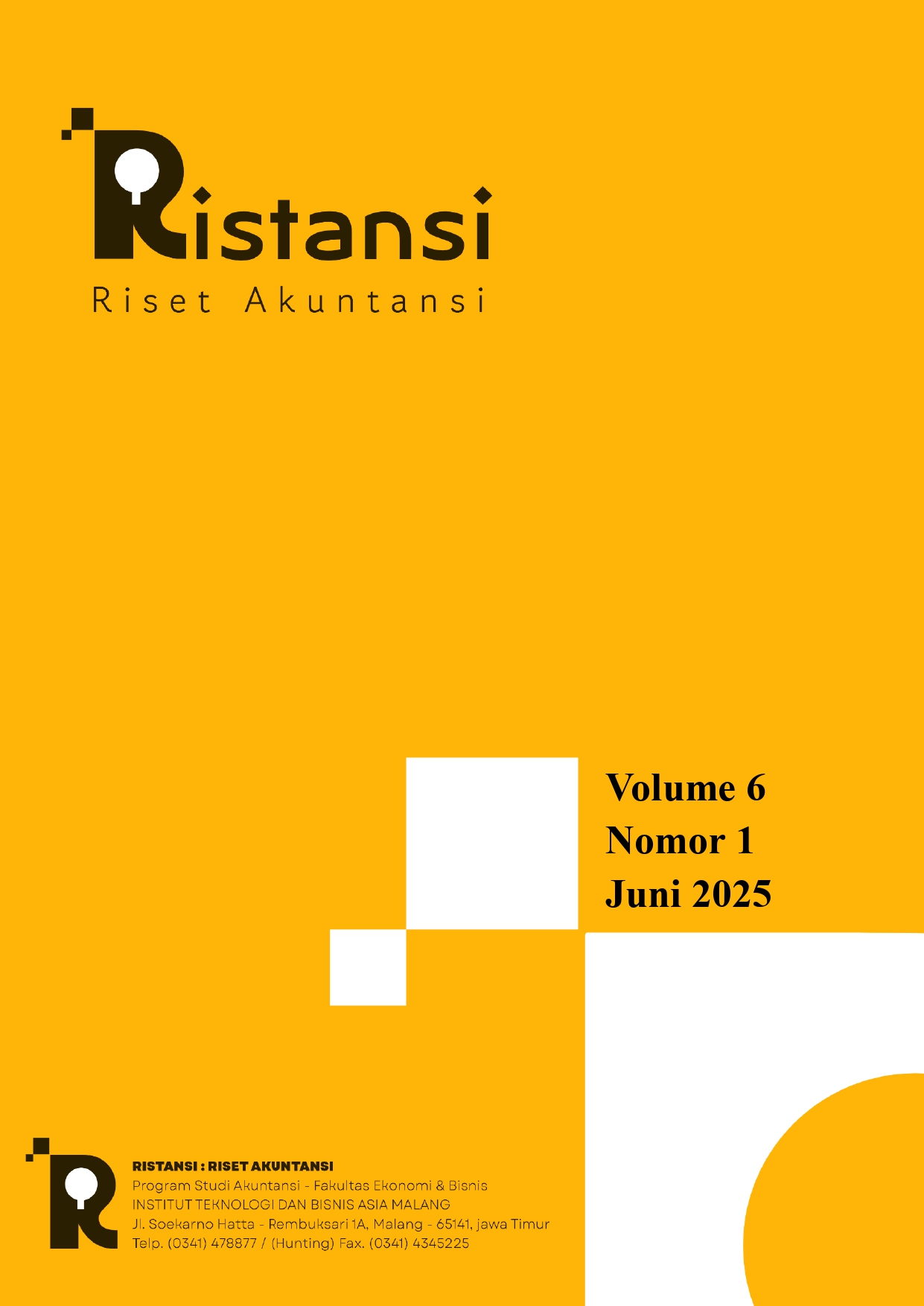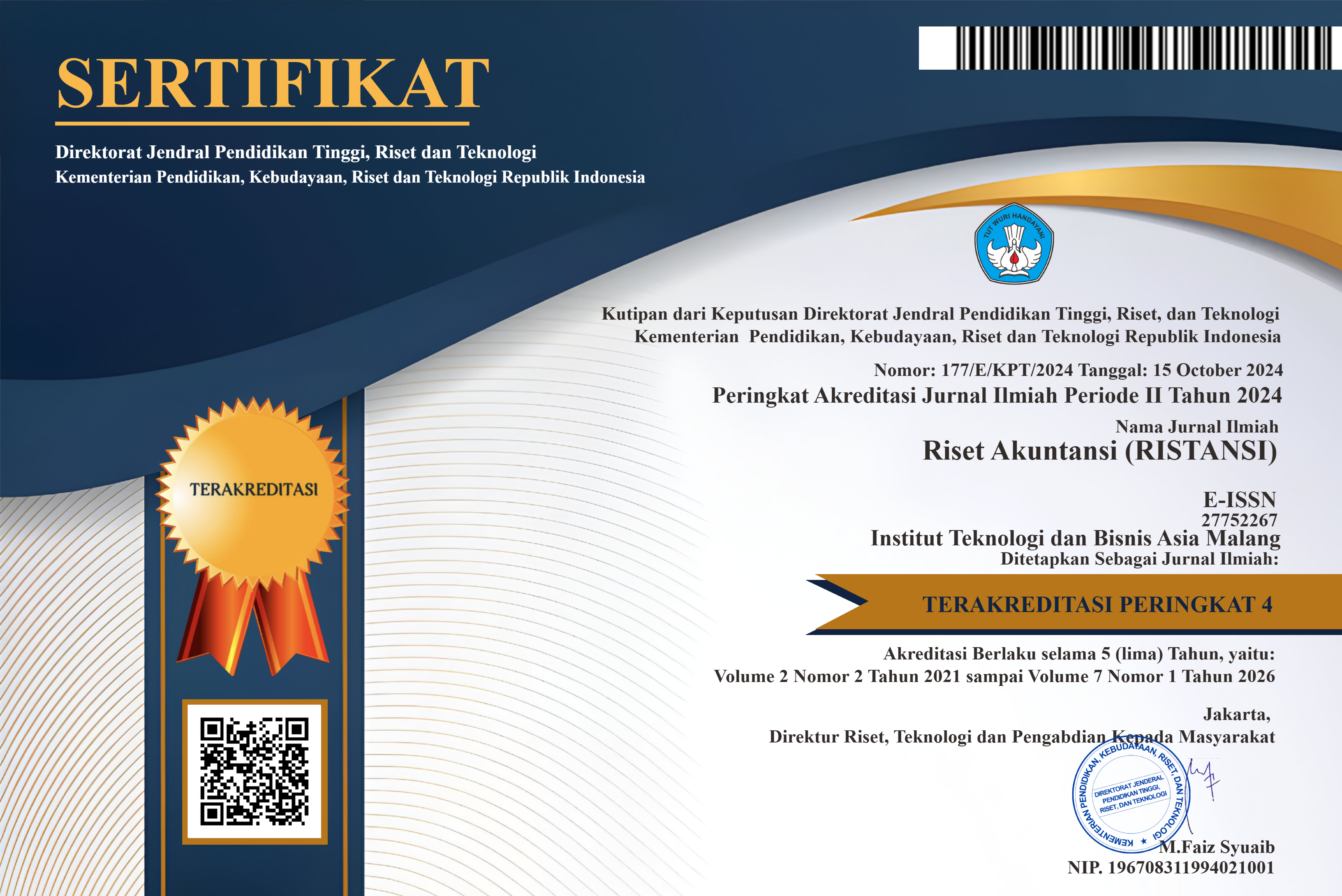FED FUND RATE DAN FLUKTUASI HARGA MINYAK: SEBUAH PENGUJIAN HERDING BEHAVIOR PADA PASAR SAHAM SYARIAH INDONESIA
DOI:
https://doi.org/10.32815/ristansi.v6i1.2458Keywords:
Herding Behavior, Fed Fund Rate, Oil PriceAbstract
With a focus on the Jakarta Islamic Index (JII), this study attempts to analyze how herding behavior is affected by changes in the Fed Fund Rate (FFR) and the oil price in the Indonesian Sharia stock market from 2019 to 2024. The sampling technique was purposive, by selecting 15 companies that were consistently included in the JII throughout the study period. Daily data was analyzed using regression method to identify the relationship between these variables and herding behaviour, which was measured using Cross-Sectional Absolute Deviation (CSAD). The results show that FFR significantly drives the herding behaviour phenomenon, where an increase in FFR tends to trigger an increase in herding in the Islamic stock market. In contrast, oil price fluctuations do not encourage the phenomenon of herding behaviour. This study concludes that US monetary policy through FFR is an important external factor influencing investor behaviour in Indonesia's Islamic stock market. However, the influence of oil prices tends to be more complex and requires further study
References
Aldeki, R. G. (2024). Impact of stock market liquidity and external factors on herding behavior in the Amman Stock Exchange. Journal of Enterprise and Development (JED), 6(2).
Arisanti, I. (2020). Herding Behaviour Around Fed Fund Rate Announcements In Southeast Asia. Jurnal Reviu Akuntansi Dan Keuangan, 10(1). https://doi.org/10.22219/jrak.v10i1.10652
Balcilar, M., Demirer, R., & Hammoudeh, S. (2014). What drives herding in oil-rich, developing stock markets? Relative roles of own volatility and global factors. North American Journal of Economics and Finance, 29, 418–440. https://doi.org/10.1016/j.najef.2014.06.009
Balcılar, M., Demirer, R., & Ulussever, T. (2017). Does speculation in the oil market drive investor herding in emerging stock markets? Energy Economics, 65, 50–63. https://doi.org/10.1016/j.eneco.2017.04.031
Banerjee, A. V, & Cvii, V. (1992). A Simple Model of Herd Behavior. The Quarterly Journal of Economics, 107(3), 797–817.
Barberis, N., & Thaler, R. (2002). A Survei Of Behavioral Finance. http://www.nber.org/papers/w9222
Basher, S. A., Haug, A. A., & Sadorsky, P. (2012). Oil prices, exchange rates and emerging stock markets. Energy Economics, 34(1), 227–240. https://doi.org/10.1016/j.eneco.2011.10.005
BenMabrouk, H., & Litimi, H. (2018). Cross herding between American industries and the oil market. North American Journal of Economics and Finance, 45, 196–205. https://doi.org/10.1016/j.najef.2018.02.009
Bhar, R., & Nikolova, B. (2009). Oil prices and equity returns in the BRIC countries. World Economy, 32(7), 1036–1054. https://doi.org/10.1111/j.1467-9701.2009.01194.x
Chaffai, M., & Medhioub, I. (2018). Herding behavior in Islamic GCC stock market: a daily analysis.
International Journal of Islamic and Middle Eastern Finance and Management, 11(2), 182–193. https://doi.org/10.1108/IMEFM-08-2017-0220
De Aghna, A., Budi, S., Septiana, L., Elok, B., & Mahendra, P. (2024). Memahami Asumsi Klasik dalam Analisis Statistik: Sebuah Kajian Mendalam tentang Multikolinearitas, Heterokedastisitas, dan Autokorelasi dalam Penelitian. In Jurnal Multidisiplin West Science (Vol. 03, Issue 01).
Devenow, A., & Welch, I. (1996). Rational herding in financial economics. In European Economic Review (Vol. 40).
Jones, C. M., & Kaul, G. (1996). Oil and the stock markets. Journal of Finance, 51(2), 463–491. https://doi.org/10.1111/j.1540-6261.1996.tb02691.x
Lao, P., & Singh, H. (2011). Herding behaviour in the Chinese and Indian stock markets. Journal of Asian Economics, 22(6), 495–506. https://doi.org/10.1016/j.asieco.2011.08.001
Pompian, M. M. (2006). Behavioral Finance and Wealth Management: How to Build Optimal Portfolios That Account for Investor Biases. Wiley.
Putra, A. A., Rizkianto, E., & Chalid, A. (2017). The Analysis of Herding Behavior in Indonesia and Singapore Stock Market.
Rahman, R. E., & Ermawati. (2020). Analysis of herding behavior in the stock market: A case study of the asean-5 and the US. Buletin Ekonomi Moneter Dan Perbankan, 23(3), 297–318. https://doi.org/10.21098/BEMP.V23I3.1362
Rizal, N. A., & Damayanti, M. K. (2019). Herding Behavior In The Indonesian Islamic Stock Market. Journal of Islamic Monetary Economics and Finance, 5(3), 673–690. https://doi.org/10.21098/jimf.v5i3.1079
Sharma, A., & Kumar, A. (2020). A review paper on behavioral finance: study of emerging trends. In Qualitative Research in Financial Markets (Vol. 12, Issue 2, pp. 137–157). Emerald Group Holdings Ltd. https://doi.org/10.1108/QRFM-06-2017-0050
Silitonga, R. S., Sadalia, I., & Silalahi, A. S. (2021). Analysis of Herding Behavior in Developing Countries. International Journal of Research and Review, 8(12), 614–621. https://doi.org/10.52403/ijrr.20211274
Statman, M. (1999). Behavioral Finance: Past Battles and Future Engagements. Association for Investment Management and Research, 18–27.
Statman, M. (2014). Behavioral finance: Finance with normal people. Borsa Istanbul Review, 14(2), 65–73. https://doi.org/10.1016/j.bir.2014.03.001
Sugiantara, P. W. (2022). Analisis Perilaku Herding Berdasarkan Kondisi Pasar Dengan Asimetri Informasi Sebagai Variabel Pemoderasi. E-Jurnal Akuntansi, 32(3), 721. https://doi.org/10.24843/eja.2022.v32.i03.p13
Tlili, F., Chaffai, M., & Medhioub, I. (2023). Investor behavior and psychological effects: herding and anchoring biases in the MENA region. China Finance Review International, 13(4), 667– 681. https://doi.org/10.1108/CFRI-12-2022-0269
Ulussever, T., & Demirer, R. (2017). Investor herds and oil prices evidence in the Gulf Cooperation Council (GCC) equity markets. Central Bank Review, 17(3), 77–89. https://doi.org/10.1016/j.cbrev.2017.08.001
Wongswan, J. (2009). The response of global equity indexes to U.S. monetary policy announcements. Journal of International Money and Finance, 28(2), 344–365. https://doi.org/10.1016/j.jimonfin.2008.03.003
Youssef, M. (2022). Do Oil Prices and Financial Indicators Drive the Herding Behavior in Commodity Markets? Journal of Behavioral Finance, 23(1), 58–72. https://doi.org/10.1080/15427560.2020.1841193
Youssef, M., & Mokni, K. (2021). Asymmetric effect of oil prices on herding in commodity markets. Managerial Finance, 47(4), 535–554. https://doi.org/10.1108/MF-01-2020-0028
Yusfiarto, R., & Pambekti, G. T. (2020). Analisis Pengaruh Variabel Makro Terhadap Return Indeks Saham Syariah Di Indonesia: Studi Pada Fenomena Perang Dagang Global. Al-Mal: Jurnal Akuntansi Dan Keuangan Islam, 01(01), 71–83.
Downloads
Published
How to Cite
Issue
Section
License
Copyright (c) 2025 Adelia Dwi Syafrina, Mega Noerman Ningtyas

This work is licensed under a Creative Commons Attribution 4.0 International License.














